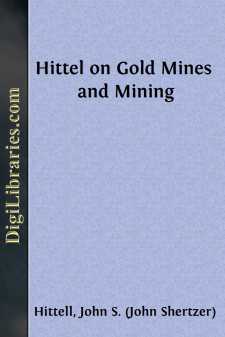Categories
- Antiques & Collectibles 13
- Architecture 36
- Art 48
- Bibles 22
- Biography & Autobiography 813
- Body, Mind & Spirit 142
- Business & Economics 28
- Children's Books 15
- Children's Fiction 12
- Computers 4
- Cooking 94
- Crafts & Hobbies 4
- Drama 346
- Education 46
- Family & Relationships 57
- Fiction 11828
- Games 19
- Gardening 17
- Health & Fitness 34
- History 1377
- House & Home 1
- Humor 147
- Juvenile Fiction 1873
- Juvenile Nonfiction 202
- Language Arts & Disciplines 88
- Law 16
- Literary Collections 686
- Literary Criticism 179
- Mathematics 13
- Medical 41
- Music 40
- Nature 179
- Non-Classifiable 1768
- Performing Arts 7
- Periodicals 1453
- Philosophy 64
- Photography 2
- Poetry 896
- Political Science 203
- Psychology 42
- Reference 154
- Religion 513
- Science 126
- Self-Help 84
- Social Science 81
- Sports & Recreation 34
- Study Aids 3
- Technology & Engineering 59
- Transportation 23
- Travel 463
- True Crime 29
Hittel on Gold Mines and Mining
Categories:
Description:
Excerpt
Chief Industry.—Mining is the chief industry of California. It employs more men and pays larger average wages than any other branch of physical labor. Although it has been gradually decreasing in the amount of its production, in the profits to the individuals engaged in it, and in its relative importance in the business of the state, it is yet and will long continue to be the largest source of our wealth, and the basis to support the other kinds of occupation.
Metals obtained.—Our mines now wrought are of gold, silver, quicksilver, copper and coal. Ores of tin, lead, and antimony in large veins, beds of sulphur, alum and asphaltum; lakes of borax and springs of sulphate of magnesia, are also found in the state, but they are not wrought at the present time, though they will probably all become valuable in a few years. Platinum, iridium, and osmium are obtained with the gold in some of the placer mines, but are never found alone, nor are they ever the main object sought by the miner. The annual yield of our gold mines is about forty millions of dollars, of our quicksilver two millions of dollars. Our silver, copper and coal mines have been opened within a year, and their value is yet unknown. All our other mining is of little importance as compared with the gold.
Gold Mines.—Our gold mines are divided into placer and quartz. In the former, the metal is found imbedded in layers of earthy matter, such as clay, sand and gravel; in the latter it is incased in veins of rock. The methods of mining must be adapted to the size of the particles of gold, and the nature of the material in which they are found. In placer mining, the earthy matter containing the gold, called the "pay-dirt," is washed in water, which dissolves the clay and carries it off in solution, and the current sweeps away the sand, gravel and stones, while the gold, by reason of the higher specific gravity, remains in the channel or is caught with quicksilver. In quartz mining the auriferous rock is ground to a very fine powder, the gold in which is caught in quicksilver, or on the rough surface of a blanket, over which the fine material is borne by a stream of water. About two-thirds of our gold is obtained from the placers, and one-third from the quartz.
A mine is defined and generally understood to mean "a subterraneous work or excavation for obtaining metals, metallic ores or mineral substances;" but this definition does not apply to our placer mines, which are places where gold is taken from diluvial or alluvial deposits. Most of the work is not subterraneous; it is done in the full light of day. In some of the claims the pay-dirt lies within two feet of the surface; in others it lies much deeper, but all the superincumbent matter is swept away.
Water is the great agent of the placer miner; it is the element of his power; its amount is the measure of his work, and its cost is the measure of his profit. With an abundance of water he can wash every thing; without water he can do little or nothing. Placer mining is almost entirely mechanical, and of such a kind that no accuracy of workmanship or scientific or literary education is necessary to mastery in it. Amalgamation is a chemical process it is true, but it is so simple that after a few days' experience, the rudest laborer will manage it as well as the most thorough chemist.
It is impossible to ascertain the amount of gold which has been taken from the mines of California. Records have been kept of the sums manifested at the San Francisco Custom House, for exportation, and deposited for coinage in the mints of the United States; and there is also some knowledge of the amounts sent in bars and dust to England; but we have no account of the sums carried by passengers to foreign countries and coined elsewhere than at London, or used as jewelry, or of the amount now in circulation in this state....


